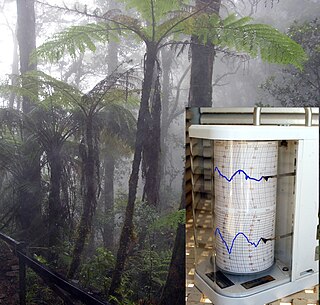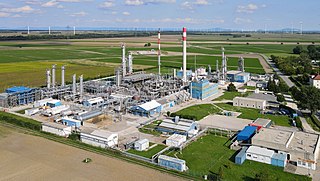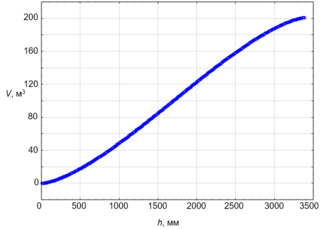Related Research Articles

Humidity is the concentration of water vapor present in the air. Water vapor, the gaseous state of water, is generally invisible to the human eye. Humidity indicates the likelihood for precipitation, dew, or fog to be present.

The dew point of a given body of air is the temperature to which it must be cooled to become saturated with water vapor. This temperature depends on the pressure and water content of the air. When the air is cooled below the dew point, its moisture capacity is reduced and airborne water vapor will condense to form liquid water known as dew. When this occurs through the air's contact with a colder surface, dew will form on that surface.
Flow measurement is the quantification of bulk fluid movement. Flow can be measured using devices called flowmeters in various ways. The common types of flowmeters with industrial applications are listed below:

A hygrometer is an instrument which measures the humidity of air or some other gas: that is, how much water vapor it contains. Humidity measurement instruments usually rely on measurements of some other quantities such as temperature, pressure, mass and mechanical or electrical changes in a substance as moisture is absorbed. By calibration and calculation, these measured quantities can lead to a measurement of humidity. Modern electronic devices use the temperature of condensation, or they sense changes in electrical capacitance or resistance to measure humidity differences. A crude hygrometer was invented by Leonardo da Vinci in 1480. Major leaps came forward during the 1600s; Francesco Folli invented a more practical version of the device, while Robert Hooke improved a number of meteorological devices including the hygrometer. A more modern version was created by Swiss polymath Johann Heinrich Lambert in 1755. Later, in the year 1783, Swiss physicist and Geologist Horace Bénédict de Saussure invented the first hygrometer using human hair to measure humidity.
Natural-gas condensate, also called natural gas liquids, is a low-density mixture of hydrocarbon liquids that are present as gaseous components in the raw natural gas produced from many natural gas fields. Some gas species within the raw natural gas will condense to a liquid state if the temperature is reduced to below the hydrocarbon dew point temperature at a set pressure.

Psychrometrics is the field of engineering concerned with the physical and thermodynamic properties of gas-vapor mixtures.

Wingtip vortices are circular patterns of rotating air left behind a wing as it generates lift. The name is a misnomer because the cores of the vortices are slightly inboard of the wing tips. Wingtip vortices are sometimes named trailing or lift-induced vortices because they also occur at points other than at the wing tips. Indeed, vorticity is trailed at any point on the wing where the lift varies span-wise ; it eventually rolls up into large vortices near the wingtip, at the edge of flap devices, or at other abrupt changes in wing planform.
A wet gas is any gas with a small amount of liquid present. The term "wet gas" has been used to describe a range of conditions varying from a humid gas which is gas saturated with liquid vapour to a multiphase flow with a 90% volume of gas. There has been some debate as to its actual definition, and there is currently no fully defined quantitative definition of a wet gas flow that is universally accepted.
Moisture analysis covers a variety of methods for measuring the moisture content in solids, liquids, or gases. For example, moisture is a common specification in commercial food production. There are many applications where trace moisture measurements are necessary for manufacturing and process quality assurance. Trace moisture in solids must be known in processes involving plastics, pharmaceuticals and heat treatment. Fields that require moisture measurement in gasses or liquids include hydrocarbon processing, pure semiconductor gases, bulk pure or mixed gases, dielectric gases such as those in transformers and power plants, and natural gas pipeline transport. Moisture content measurements can be reported in multiple units, such as: parts per million, pounds of water per million standard cubic feet of gas, mass of water vapor per unit volume or mass of water vapor per unit mass of dry gas.
The Twister supersonic separator is a compact tubular device which is used for removing water and/or hydrocarbon dewpointing of natural gas. The principle of operation is similar to the near isentropic Brayton cycle of a turboexpander. The gas is accelerated to supersonic velocities within the tube using a De Laval nozzle and inlet guide vanes spin the gas around an inner-body which creates the "ballerina effect" and centrifugally separates the water and liquids in the tube. Hydrates do not form in the Twister tube due to the very short residence time of the gas in the tube. A secondary separator treats the liquids and slip gas and also acts as a hydrate control vessel. Twister is able to dehydrate to typical pipeline dewpoint specifications and relies on a pressure drop from the inlet of about 25%, dependent on the performance required. The fundamental mathematics behind supersonic separation can be found in the Society of Petroleum Engineers paper entitled "Selective Removal of Water from Supercritical Natural Gas". The closed Twister system enables gas treatment subsea.

Natural-gas processing is a range of industrial processes designed to purify raw natural gas by removing contaminants such as solids, water, carbon dioxide (CO2), hydrogen sulfide (H2S), mercury and higher molecular mass hydrocarbons (condensate) to produce pipeline quality dry natural gas for pipeline distribution and final use. Some of the substances which contaminate natural gas have economic value and are further processed or sold. Hydrocarbons that are liquid at ambient conditions: temperature and pressure (i.e., pentane and heavier) are called natural-gas condensate (sometimes also called natural gasoline or simply condensate).

Custody Transfer in the oil and gas industry refers to the transactions involving transporting physical substance from one operator to another. This includes the transferring of raw and refined petroleum between tanks and railway tank cars; onto ships, and other transactions. Custody transfer in fluid measurement is defined as a metering point (location) where the fluid is being measured for sale from one party to another. During custody transfer, accuracy is of great importance to both the company delivering the material and the eventual recipient, when transferring a material.

Airport weather stations are automated sensor suites which are designed to serve aviation and meteorological operations, weather forecasting and climatology. Automated airport weather stations have become part of the backbone of weather observing in the United States and Canada and are becoming increasingly more prevalent worldwide due to their efficiency and cost-savings.
Supersonic gas separation is a technology to remove one or several gaseous components out of a mixed gas. The process condensates the target components by cooling the gas through expansion in a Laval nozzle and then separates the condensates from the dried gas through an integrated cyclonic gas/liquid separator. The separator is only using a part of the field pressure as energy and has technical and commercial advantages when compared to commonly used conventional technologies.
The Glossary of fuel cell terms lists the definitions of many terms used within the fuel cell industry. The terms in this fuel cell glossary may be used by fuel cell industry associations, in education material and fuel cell codes and standards to name but a few.

Instrumentation is used to monitor and control the process plant in the oil, gas and petrochemical industries. Instrumentation ensures that the plant operates within defined parameters to produce materials of consistent quality and within the required specifications. It also ensures that the plant is operated safely and acts to correct out of tolerance operation and to automatically shut down the plant to prevent hazardous conditions from occurring. Instrumentation comprises sensor elements, signal transmitters, controllers, indicators and alarms, actuated valves, logic circuits and operator interfaces.
Michell Instruments consists of a group of eight operating companies located in the UK, France, Netherlands, Germany, Italy, US, China and Japan. The group is involved in the design, manufacture and sale of a wide variety of industrial instrumentation including relative humidity, dew point, moisture in gases and liquids and oxygen analysis.
In the petroleum industry, allocation refers to practices of breaking down measures of quantities of extracted hydrocarbons across various contributing sources. Allocation aids the attribution of ownerships of hydrocarbons as each contributing element to a commingled flow or to a storage of petroleum may have a unique ownership. Contributing sources in this context are typically producing petroleum wells delivering flows of petroleum or flows of natural gas to a commingled flow or storage.
Headspace gas chromatography uses headspace gas—from the top or "head" of a sealed container containing a liquid or solid brought to equilibrium—injected directly onto a gas chromatographic column for separation and analysis. In this process, only the most volatile substances make it to the column. The technique is commonly applied to the analysis of polymers, food and beverages, blood alcohol levels, environmental variables, cosmetics, and pharmaceutical ingredients.
References
- ↑ Hydrocarbon Dew Point
- ↑ White Paper on Liquid Hydrocarbon Drop Out in Natural Gas Infrastructure (NGC+ Liquid Hydrocarbon Dropout Task Group, October 15, 2004)
- ↑ White Paper on Liquid Hydrocarbon Drop Out in Natural Gas Infrastructure Archived 2008-10-10 at the Wayback Machine (NGC+ Liquid Hydrocarbon Dropout Task Group, September 28, 2005)
- ↑ A. J. Kidnay and William Parish (2006). Fundamentals of Natural Gas Processing (1st ed.). CRC Press. ISBN 0-8493-3406-3. (See page 110)
- 1 2 Andrew Brown et al (May 2007). "Comparison of Methods for the Measurement of Hydrocarbon Dew Point of natural gas", UK National Physical Laboratory Report AS 3, ISSN 1754-2928.
- ↑ "Automation Solutions | Emerson US".
- 1 2 Vympel Instruments (Hygrovision BL Hydrocarbon Dew Point Analyzer)
- ↑ ZEGAZ Instruments (HCD5000(TM) Hydrocarbon Dewpoint Analyzer)